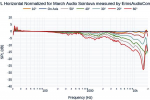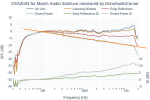really nice one but somehow the on axis rise in high frequencies keeps me itchy
I am a little suprised by all the praising because of the HF rise. I have seen other speakers beeing lynched here for less lol
The axis frequency response increase above 7kHz is not quite as dramatic as it seems if you don't look at the axis frequency response only - which one should never do.
The Sointuva-WG (
SB Acoustics WG) is not designed for constant directivity radiation - whether this is an advantage or disadvantage, is a matter of opinion and taste and must each decide for themselves.
Above about 5kHz the radiation narrows. This can be seen well if you look at the frequency responses normalized to the axial frequency response:

Please ignore, for this analysis, the widening in the horizontal radiation in the range 1.7-3kHz, this is the influence of the speaker cabinet width (edge diffraction).
Very roughly, above 5kHz, at the latest 7kHz, the non-axis frequency responses (>20°) are no longer parallel to the axis frequency response.
For comparison, here is a simulation of an identically sized waveguide (without woofer, WG only) in a loudspeaker cabinet - please ignore everything above 10kHz (from there on the simulation becomes unreliable). The waveguide is designed for constant directivity (and supress of edge diffraction) - for an operating range above 1.3kHz.

Now compare the 60° frequency response of the Sointuva-WG (
SB Acoustics WG) and the CD-WG. With the CD Waveguide, the 60° frequency response continues to run parallel to the axial frequency response, quite differently with the SB Acoustics WG, where the FR drops significantly from 4.5kHz and is, at 10kHz, already 7dB below the average sound pressure level.
So what does this mean for "correct" speaker tuning?
This, of course, is for the loudspeaker designer to decide. If you look at the spinorama of the Sointuva with WG, it becomes clear that the speaker was optimized for the most evenly sloping sound power or/and PIR curve possible.

 Source
Source
The significant frequency response drop outside the axial frequency response, for frequencies above 5kHz, leads to a drop in the sound power frequency response and must therefore be compensated by increasing the axial frequency response.
A straight axis frequency response above 5kHz would therefore have been the wrong decision for the intended design goal (as uniform SP and PIR as possible).
If you want to do some nitpicking, you might note that 1dB less sound pressure around 15kHz would have been more optimal, but such things should always be decided by a listening test, not by measurement curves - maybe it sounds more airy this way.
With a CD-WG, such a tuning would lead to a significant increase in SP above 7kHz and would most likely sound too bright and obtrusive.
Sorry for the long ramblings, just wanted to make clear again that the sole consideration of the axial frequency response is not sufficient to judge a speaker (except for really significant outliers) and is not able to reveal the design goals - whether you like this tonally, again, everyone must decide for themselves.











